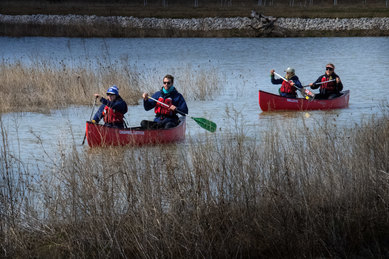Setting a New Benchmark for Lake Erie’s Coastal Restoration
Nearly 1,000 acres of land owned by a single entity, right on the shores of Lake Erie, sounds like an incredible redevelopment opportunity. Commercial, residential, mixed-use – a whole new community of activity could be envisioned. Now consider that this land is within the former Black Swamp regions of Lake Erie and exists as fertile farmland only due to the miles of dikes separating it from the powerful forces of the lake itself. A different picture of what it could or should be as a redeveloped landscape emerges.
Enter Metroparks Toledo, driven by their desire to provide a park within five miles of every resident in Lucas County, Ohio and their focus on natural systems preservation and restoration. An initial vision for restoring valuable coastal wetlands within the Lake Erie basin began a nearly three-year design effort with a SmithGroup-led team and two years of construction, culminating in Howard Marsh Metropark. Located approximately 15 miles from downtown Toledo, the park boasts numerable recreational amenities – seven miles of greenways, seven miles of blueways, boat and kayak launches, portages, fishing and hunting – all interwoven within diverse, ecological habitats.
Garnering public input and support was a key priority from the outset, to ensure that the transformation of farmland to wetland provided public benefit for all from a variety of viewpoints. Important groundwork was laid by explaining the historical significance of lost coastal wetlands, and the value that restoration could provide from a water quality perspective. If every acre of restored coastal wetland could remove 13 pounds of phosphorous from runoff annually, restoring over 750 acres of coastal wetlands could have a significant future impact on reducing harmful algal blooms in the Western Lake Erie basin.
The addition of ecologically diverse habitat within a critical migratory bird corridor provided further incentive to support this coastal wetland restoration. The tremendous environmental benefits the project could bring by enhancing resiliency and environmental diversity of flora and fauna within the Great Lakes Basin won the support of numerous funders and governmental agencies. In conjunction with funding from the Metroparks Land Levy, additional support came from the National Oceanic and Atmospheric Administration (through Great Lakes Restoration Initiative funding), the Ohio Department of Natural Resources Division of Wildlife, and the Clean Ohio Fund.
All of these funders are seeing clear proof of the value of their ecological investment. A recent story in The Toledo Blade highlights how “the Great Lakes region’s largest coastal wetland restoration project has equaled or surpassed expectations in nearly all biological metrics.” Fourteen months following construction, 226 species of birds — roughly half of known species in Ohio — have already been spotted at Howard Marsh, drawing 5,300 eco-tourists to the park during this spring’s Biggest Week in American Birding.
Integral to achieving the project’s restoration goals was the thoughtful integration of recreational opportunities within these restored wetlands. Howard Marsh offers the public the opportunity to experience and interact with a variety of habitats and wildlife, highlighting the critical role our communities can play by preserving our coastal environments for the benefit of humans and nature. The park's reception of the National Recreation and Park Association's 2019 Innovation in Conservation Award is a testament to this successful blend of restoration and recreation.
Howard Marsh may very well be a one-of-a-kind restoration project considering its size and location within the region, but its successful design process and approach for integrating recreation within restored habitats is scalable across geographical regions, locales (urban to rural) and size (single to multiple acres). This integration is the key to advancing a new kind of mixed-use restoration for Lake Erie and other environmentally challenged waterways.
Read more about how this project was made possible in Emily McKinnon’s article for Parks & Rec Business.
